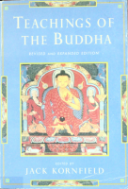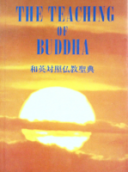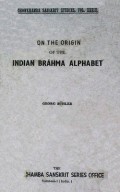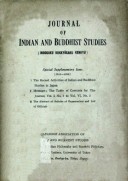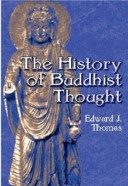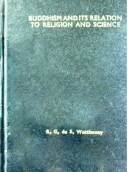Tìm Sách
Sách tiếng Anh-English >> A critical Study of the Life and Works of Sariputta Thera
Thông tin tra cứu
- Tên sách : A critical Study of the Life and Works of Sariputta Thera
- Tác giả : Bhikshu THÍCH HUYEN-VI (Le-Van-Huyen), M.A.. Ph. D.
- Dịch giả :
- Ngôn ngữ : Anh
- Số trang : 319
- Nhà xuất bản : the Publication Department Van-Hanh University- Saigon
- Năm xuất bản : 1972
- Phân loại : Sách tiếng Anh-English
- MCB : 12100000002641
- OPAC :
- Tóm tắt :
A Critical Study of THE LIFE AND WORKS OF SARIPUTTA THERA
A Thesis presented and approved for the Degree of Doctor of Philosophy In the Faculty of Arts of the Magadha Univesity 1971
By
Bhikshu THICH HUYEN-VI (Le-Van-Huyen), MA., Ph. D.
Published by the Publication Department Van-Hanh University
SAIGON
1972
A Critical Study of THE LIFE AND WORKS OF SARIPUTTA THERA
A Thesis presented end approved for the Degree of Doctor of Philosophy In the Faculty of Arts of the Magadha University 1971
Lecturer in Chinese Nava Nalanda Mahavihara, Nalanda, Patna, Bihar, India.
Published by the Publication Department Van-Hanb University
SAIGON
1972
By
Bhikshu THÍCH HUYEN-VI (Le-Van-Huyen), M.A.. Ph. D.
Foreword
A good deal of research on the Life and teaching*of Lord Buddha ha*s already been done. But comparatively little has been done onthe life and works of Hi*s disciples Ofcourse nothing much i*s known about moast of them except that they joined the Shangha and after due endeavours attained the variousstagesof sainhood. However, fortunately for us, the tradition has preserved the life account* of the most important among them.This is specially true ofAsiti mahasavakas or eighty great diaciples who were well known fortheir spiritual attainment*s and achievement*. Among them, by virtue of merit, Sarip wa* accordedChe first piece, and hebecame Aggamabdsdvaka or the chief disciple of the Matter.
In fact, Sdriputta wa* only next to the Matterin hie attainment* and achievement*. In the word* of the Matter himtelfit teas Sdriputta who turned the Wheel of Low after Him (Dhammacakkaiq anuppavatteti). It is cm recordthat on several occasions the Buddhaadvised Hi* other disciple*to follow thenoble example of Sariputta spiritual discipline. Sdriputta played the most important part in conducting the affair*s of the Sangha and promoting the welfare ofSaddharma.
So dominating wa*s the personality of Sariputta vis-vis the sanghathe Buddha--Asana that on his parinibbana it left a big vacuum. There are several significant statement* on the point ascribed to the Master. When the Buddha attended the first assembly of the Sangha after the parinibbana of Sariputta, deep silence prevailed for sometime and then breaking it He remarked that without Sariputta the Sangha appeared to be rather desolate. On another occasion, also immediately after Sariputta*s parinibbana, while addressing another assembly of His disciples at Ukkacela, the Lord referred to the absence of His chief disciple. On this occasion He compared the Sangha to a big and beautiful spreading tree and Sariputta to its biggest branch. Now that branch which enhanced its beauty was no more and the big tree was looking out of shape. These touching remarks bear ample testimony to the high esteem that Sariputta stood in the eye of the Master.
Accounts ofthe life of the great saint are found scattered in various Nikaya and their commentaries. But so far no systematic work was available on the subject matter. This need has been fulfilled in the present work by Ven. Bhikshu Thich Huyen-Vi.
In this work the authorhas covered all the important aspects of the life of Sariputta — life from birth to parinibbana, achievements and qualities, spiritual evolution, and works and discourses.
The present work is mainly based ofmaterials available in the Pali literature — both canonical and exegetical. The author has also drawn upon the Chinese accounts which are based on Sarvartivadin and Mahayana traditions. While there is agreement on the main points, there are some differences on minor points. It appears that the various traditions borrowed their materials from acommon source and workedout the detail according to their interest. It may be noted here in passing that since the accounts that have come down to us in other traditions are rather scanty, one has to depend on the Pali tradition to present anything like a full picture of the life andmission ofthe great saint.
While dealing with the contents of the discourses of Sariputta,the authorhas made a comparative study of them as foundin the Pali and Chinese versions, the latter being the translations of the Agamas. He has tried his best to make the work as comprehensive as possible. His knowledge of Pali and Chinese has stoodhim in good stead in this work.
The life ofa saint can never be a colourful one and therefore of general interest. It is the life of theman ofthe world whoseinterests are legionand who plays many roles that could becolourful. His is a life ofmultiplicity (papanca) full of attractive features and henceit could create distractions and thrilling sensations forthe average man of the world. On the contrary the saint has to lead a disciplined and dedicated life away from the complications anddistractions of the world. He has toattain the mental unificationand integration by following the spiritual path. It is one of simplification, purification andpenetration. By followingthis path he has to go beyond the sense sphere andattain that inner stillness where the mystery of lifeis revealed and the ultimate Truthis realized.This is true, mutatis mutandis, even of a man given to unravellingthe mysteries of the phenomenal world. A scientist too has to lead a dedicated life. He has to forego manygood things of the world whichthe average man may enjoy. He has to find his delight in his discoveries which are also thrilling but of a higher nature. If he is lackingin this spirit his work would suffer to thesame extent.
The life of a saint isvaluable for the light it sheds on the spiritual path. Thisis true of ArahantaSariputta also. His life was anoble example of sila or virtue, samadhi or concentration andpanna or intuitive wisdom. Thesedivine qualities foundtheir fulfilment inhis life.
For most people spiritual lifeis associated with the attainment of supernormal powersleading to the performance of miracles. It is true that they area by-product of the higher life and are oftenattributed to great saints.But they have never beenupheld as a sure criterion of spiritual attainments. In fact too much interestin them could even be ahindrance on the spiritual path. For the same reason. Lord Buddha, as Ỉaid downin the Vinaya rule No. 58 made it an offence far His disciples to perform miracles. life of Sarỉputta stands as an illuminatingvindication of this matter. Although he had attained, nice other great Arahantas au the supernormal powers, yet, as recorded in the Theragatha he did not take any interest ln the practice and performance of miracles(idđhỉ). Then again, this advice to AnuruddhaThera if illustrative of this point. Anuruddha was the foremost among those disciples ofthe Tathagata who were proficientin the performance of miracles. With all the supernormal powers Anuruddha, inthe beginning, was not able to attain the spiritual stages. He did not know the fact that in those who are still in the mundane plane ( lokiya-bhumi ) ego works in a very subtle form in relation to the psychic powers. When he failed in Ms endeavours, he went to Sarỉputta forguidance. The former told the latter that in spite of his psychic powers he was not able to attain the spiritual stages. Sàriputta at once pointed out to him where the rub was. He told him that itwas the vanity of psychic power which created hindrance for Mm, and then advised him to direct his mind towards the state of immortality. By acting in the light of his instructions Anuruddha was able to attain the highest state of sainthood (arahatta) before long.
It is true that Lord Buddha and some of his enlightened disciples made use of the psychic powers occasionally, and that only to direct the minds of certain individuals towards the spiritual path. But then in the case of those who are still in the mundane plane, they can do more harm than good. Devadatta's is a glaring example. After attaining some psychic powers he became so entry for name, fame and gain that he lost all good sense. His ambition dragged him down to the lowest depth of degradation. Sảriputta' life illustrates thefutility of psychic powers in the attainment of spiritual emancipation.
With all Ms material prosperity man is not happy today. The reason is that he has lost sight of the higher values of life. Man can attain peace and happiness only by regaining the right perspective of life. It is a good sign that in certain quarters they have begun to revaluate the vaines of life. Inthis the life and teachings of great saints like Sàrỉpnttacan guide them in the right direction. They serve like beacon lights in a world lost in spiritual darkness. The present work can serve this purpose.
Having the knowledge ofPali and Chinese Ven. Bhikshu Thich Huyền-Vi is well equipped to serve the cause of Saddharma in a wider sense. While congratulating him on his present work, I wish Mm further success in this line.
Ven. Dr. V. Dhammaratana MA.., D,PhiL, Professor of Pâli and Buddhis-Philosophy. Nava Nàlandá Mahấvihàra,
Patna,Bihar, India.
8-9-1971
Preface
It it with great honour and pleasure that Van Hanh Publication Department has broughtabout the publication of Venerable Thick Huyen Vi's thesis on:" Acritical study of The Life and Works of Sàriputta Thera".
The work is commendable in itself,in that, it deals with Sáriputta Thera, one of the most prominent disciples of the Buddha, the foremost in wisdom. Not only wisdomit the ultimate aspiration for ail those who wantto follow the steps of the Buddha,it it inscribedin the motto of Van Hanh University itself: Duy Tue Thi Nghiêp.
And if we care to analyse the differencein between Kamma or action and Panna or wisdom, the world of desire (Kàmàvacara)it dominated by Kamma, while in the Lokuttara or transcendental world, Pannà replaces Kamma. Sowe have here a meeting groundin uhsdomwhich it best represented by Sáriputta Therahimself.
Further more Venerable Thick Huyen Vi is well known to us fora long time.We still remember the time, about 1964, when we welcomed him for the first time at Nalanda where he came for sutdy, with a scanty knowledge of English and with no knowledge at allin Pàli. But we had full confidencein him. at he had left a train of goodwork done at home in Vietnam, both at excellent preacher and asdevotional workerin various Dhammaactivities. He did not belie in our expectation, and the present thesis. 4 years of hard work afterhit M-A. bearsliving testimony to hit excellent worksin matter ofresearch and study.
In Vietnam, suchkind of research work is rather rare, if not inexis- tent. Either a Buddhist selectsa sutta and devotes hit own life, for study and practiceand feelsquite satisfied withit. He has no time or no training to botherhimself with otherinnumerable discourses dealing with the same topics. Or he considers study or book a kind of palibodha or impediment to hisspiritual training, and that tooshould be discarded.We think that thisexcellent work done by Venerable Thich HuyenVi it a kind of eye-openerto many short-sightedpeople and we hope that our publication at least fulfillsthis moderateaim.
As the authorit still at Nàlanda, whilethe printing it done in Vietnam, some mistakes are bound to occur, when consultation of anykindit virtually impossible. The author does wot follow strictly the alphabetical order (either English or Pali) in hit indexes, for what reason unknow to us. So we prefer to respect his arrangements. As for diatrical marks for Pali and Sanskrit terms, both languages are still not in use in the printing press of Saigon. So please forgive any lapses that occur. The Chinese terms are not a problem in Vietnam. At least we hope so.
The cost ofthe publication is covered by many donors who. are mostly Venerable Thich Huyen Vi’s disciples. So a list of them is printed at the end of the book in recognition of their contribution.
Abbreviations
Contents
Pige
Introduction . *
III. CHAPTER THREE Spiritual Evolution of Sàriputta Section 1 Three-fold Bodhi :
(a) Sammàsambodhi ..
(b) Paccekabodhi
(c) Sàvakabodhi .
— 2 Bodhi of the Chief Disciple . ....
— 3 Legends on the Spiritual Evolution
IV. CHAPTER FOUR Works and Discourses of Sàriputta
Section 1 Abhidhamma . . —
2 Patisambhidàmagga
(d) 3 Niddesa
(e) 4 Discourses of Sariputta :
— Dighanikaya
— Majjhimanikaya
— Samyuttanikaya
— Anguttaranikaya
(f) 5 Classification of the Suttas according to their topics
CONCLUSION
Appendixes
Index of some Doctrinal Terms
Index of Chinese Terms
Bibliography
 Facebook
Facebook
 Google
Google
 Google+
Google+
